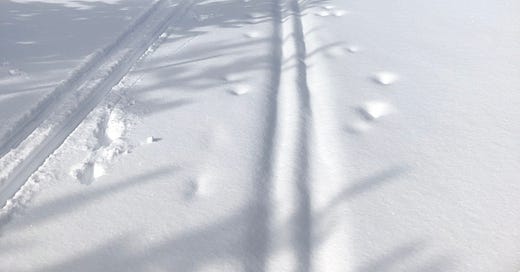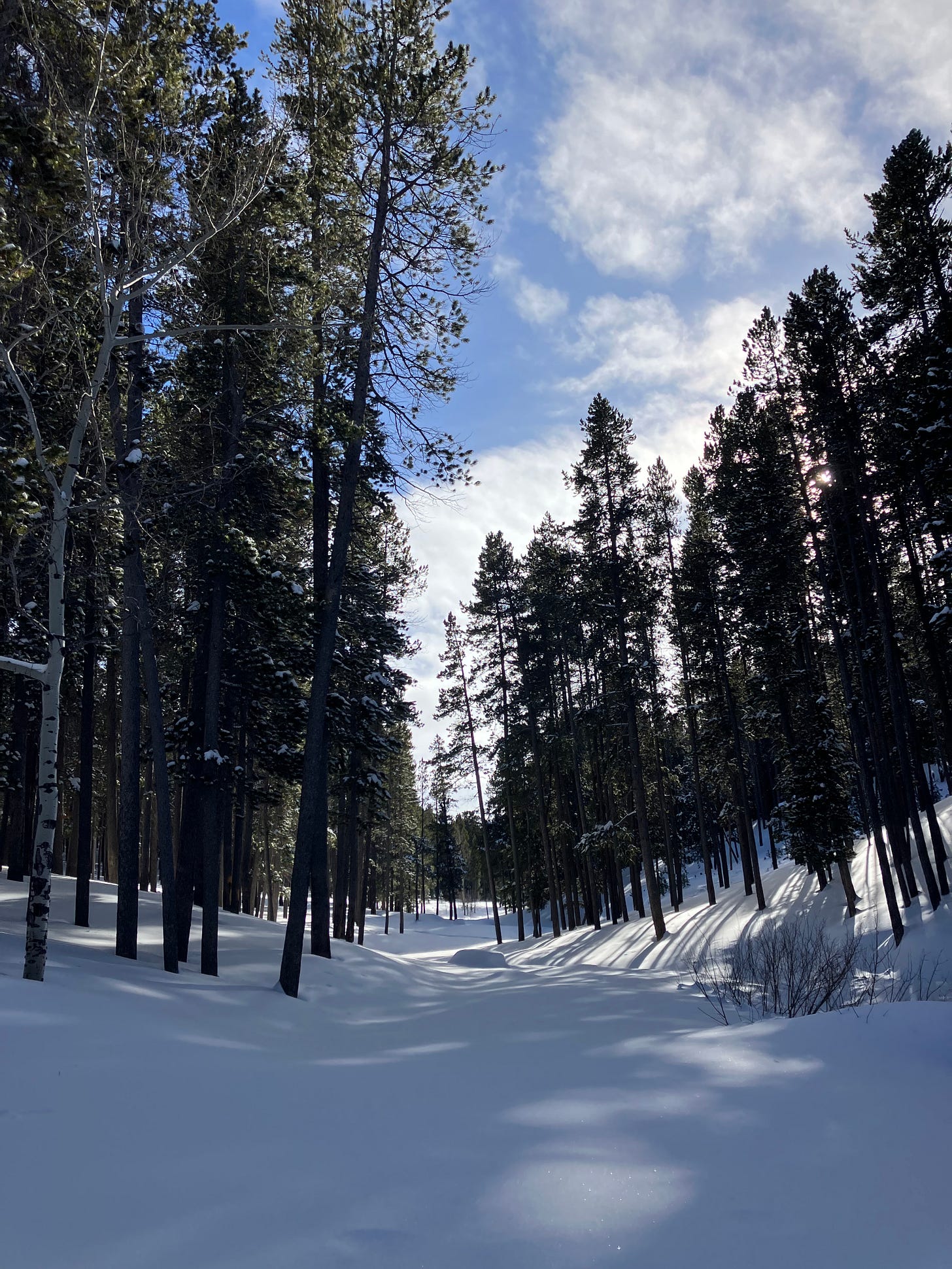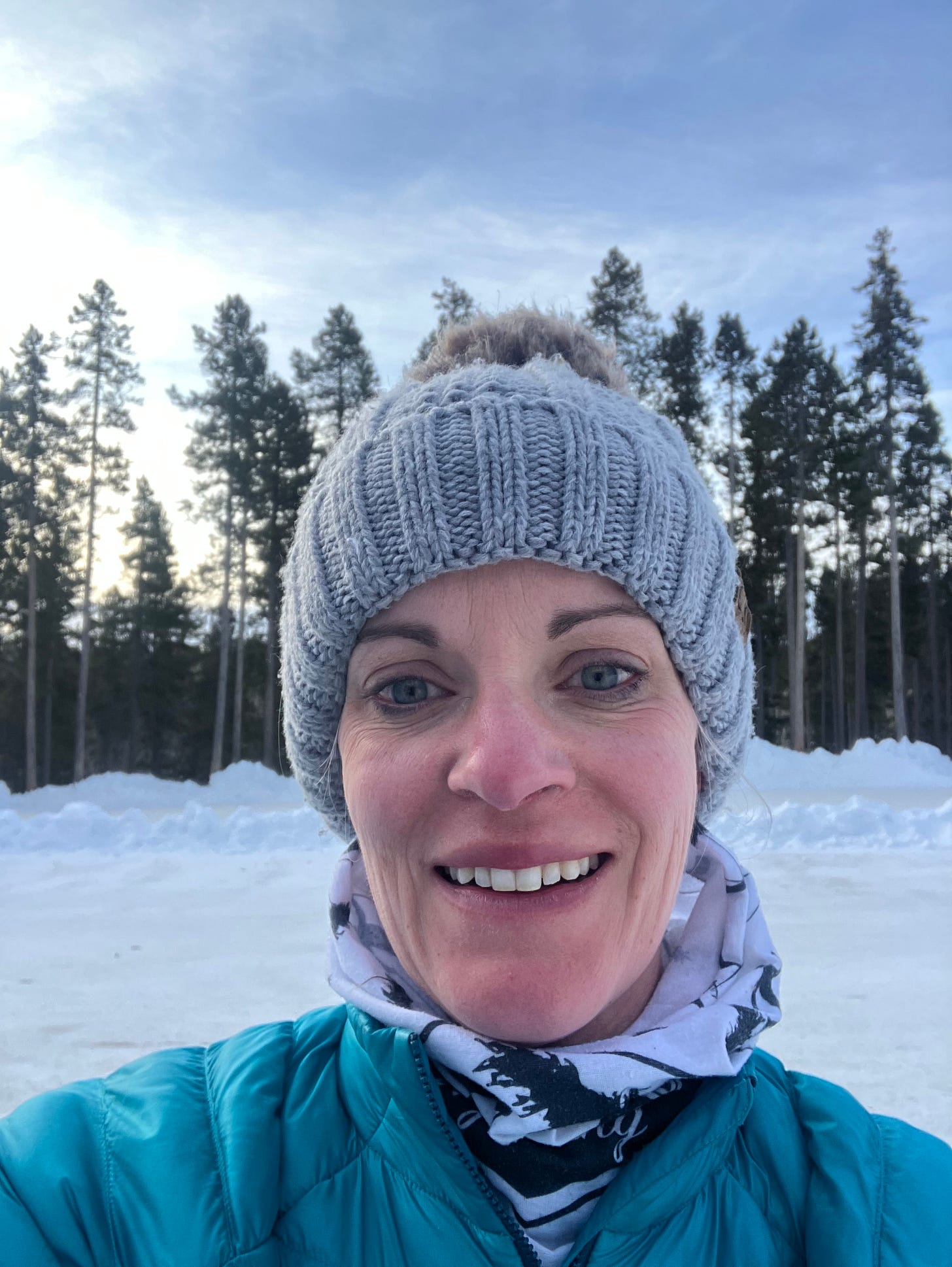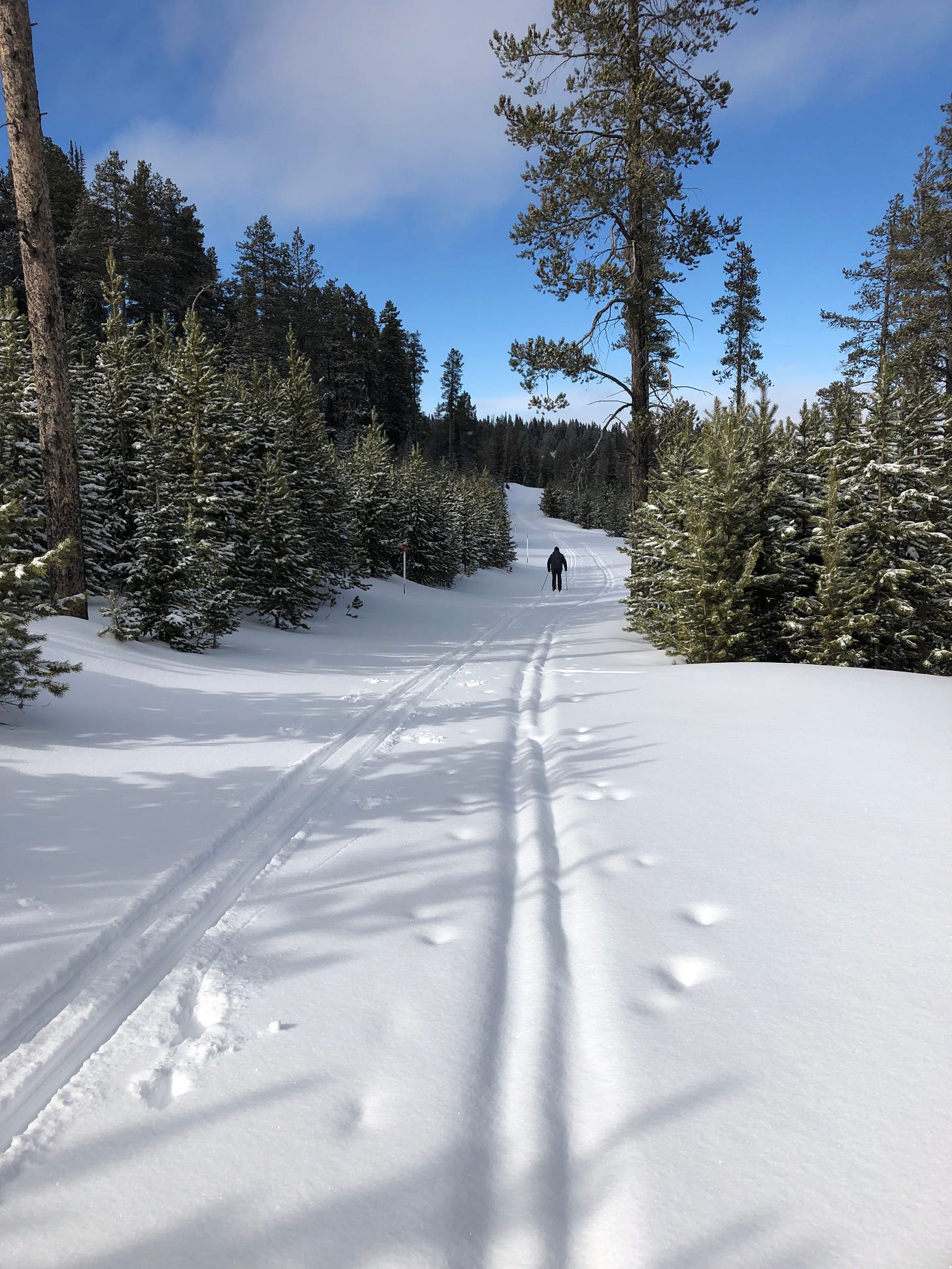This year, 2023, has brought record lows and snows to much of the continental United States. Here in Wyoming, we’ve gotten more snow than the past few years, and what we’ve learned in six winters here is that more snow means more skiing—cross-country skiing (XC), to be precise. We’ve grown to love cross-country, which might seem trivial, in the face of all the mess going on in the world. But slide along with me and learn why loving XC improves our lives and broadens our world.
I wrote most of the the following in February 2019. Though lightly edited and updated, it still remains true. I hope you enjoy it!
1.Nordic skiing is a sport that began with a practical outdoor purpose, and its history combines ingenuity and courage that inspire us.
Not many people lay claim to loving frosty weather for significant portions of the year, let alone finding fun ways to navigate mountains–and mountains, and mountains–of snow. Cross-country skiing is, in fact, one awesome invention borne from humans otherwise torpid, shivering, and probably half-crazy from cabin fever.
Basically, Nordic skiing began as a way for one snow-bound guy to get to his neighbor’s house more easily. Later, it evolved into (what else?) a strategy for military maneuvering and eventually made its way into the sporting arena in the eighteenth and nineteenth centuries. Originating in Norway—I know, you’re shocked—Nordic skiing is unsurprisingly dominated by Scandinavian athletes at Winter Olympic games. Think about it: if your great-grandfather had to go seven kilometers to his buddy Sven’s place, or to find something fun to do in the white wilderness that lay in his backyard for eight months out of the year, what would be his fix? If you were in his place, you’d appreciate and probably master cross-country skiing, too! (Especially if your great-grandfather ended up marrying Sven’s sister. Which he probably did. Hey, a romantic motive for heading out into sub-freezing temperatures makes a lot of sense.)
Knowing all this makes us appreciate Nordic skiing more than we already do. We like that XC has a history. It’s an activity that ties us to our forebears–hey, our last name is Olson!–and to people who knew exactly how to make do with long winters in frigid and avalanche-prone climes. Links to the past remind us that we aren’t the center of the universe or somehow better than our ancestors. Our technology-improved skis might be better than the retro wood ones of Sven and his immediate progeny, but I doubt our abilities to ski, or to understand the intricacies of snowfall and weather, or how to navigate the unrecognizable outdoors could at all approach theirs. They set the bar, and with the resources they had, they whittled it so they could perform controlled slides downhill at heart-stopping speeds. That’s chutzpah, and they’ve got our respect and our desire to be a bit more like them.
2. XC allows us to cherish our local environment–and in the winter, no less.
We still can’t believe that we live in Wyoming, for many reasons. One of the big ones is that we live just a fifteen minute drive from the world-class cross-country trails on Casper Mountain. It’s an easy, scenic drive well before we reach the trailheads where the Casper Nordic Club Lodge used to stand. Sadly, after several recent winters of record snowfall, the lodge’s roof was deemed structurally unsound, and the building was taken down. But the trails and the skiers are still there, and so is lots of wildlife. We’ve spotted about a dozen wild turkeys hanging out in a copse at the base of the mountain right next to the road. A mule deer was standing with them, like they hang out all the time—which they probably do. We’ve also seen pronghorn antelope on many occasions. On the trails themselves, we find rabbit and other tracks, and sometimes the scat that tells us we just missed meeting our furry friends face-to-face. Once this winter, some mule deer does actually blocked part of the trail as we approached. Their ears flicked as we skied past, and they only turned to run into the trees after we’d swooshed by. Witnessing wildlife in their home, in a place we also call home, makes us want to conserve and protect our mutual habitats.
And the views on the trails are breathtaking. I loved snow as a kid, and it never stuck around long in Ohio or Kentucky. The closest I got to consistently experiencing the magical sight and feel of whirling flakes deep in a forest happened during the Waltz of the Snowflakes in productions of The Nutcracker I danced in. But when we ski, we glide through a winter wonderland every time. Sparkling, glittering, unbroken hills of white meeting a cerulean blue sky; evergreens towering and clustered, weighted with blankets of heavy white; silences so still we can hear clumps of softly falling snow on the mountain–we experience this every single time we head out on our skis. Many trails criss-cross the top of the mountain, and up there we can admire the prairie three thousand feet below us reaching to the horizon and the white caps of the distant Bighorn Mountains. With these kinds of viscerally moving views, can you blame us for becoming skiing regulars?
3. XC keeps us in shape—and in the winter, no less.
Many so-called winter sports take place mainly on indoor rinks and are not actually very lay-friendly. Take figure skating. It’s fantastic, if you’re a teenager with great knees, rock-solid tendons, and crazy dedication to mastering airborne spins. We actually like to do it occasionally, because it’s fun in short spurts and it helps us improve our skate skiing. But landing on ice can be, well, brutal. Olympic “sports” like curling won’t exactly raise your heart rate, and others like the luge are glorified sledding, in our humble opinions. But cross-country skiing? Few other sports combine upper body athleticism, core strength, and cardiovascular challenge quite like it–and it always takes place outdoors. It’s one of the best full-body workouts that we can get. It requires herringboning up hills and double-poling down, not to mention the constant muscle work required to maintain balance. As a decades-long study of cross-country skiers showed, while genetics can sure help us reach old age (thank you, great-grandfathers!), skiing is an excellent way to improve our chances of relishing our golden years (and cut down on our risks of heart disease and cancer).
But most anyone who’s tried cross-country skiing knows that it’s a simple concept but also just plain hard to actually do. In other words, it’s an activity most people would pursue, or even watch, like they would a root canal. “Cross-country skiing is the least glamorous, least pyrotechnic, least watchable of the major Olympic sports. … [It’s] where the elegant majesty of winter sports goes to die an excruciatingly drawn-out death,” writes Sam Anderson in “What Cross-Country Skiing Reveals About the Human Condition,” a love-hate ode to cross-country skiing. “So why would anyone do it?”

I know, I know–the skeptics among you are currently echoing the top entry in Urban Dictionary for cross-country skiing. Only “people who like the cold, hills and exercise induced asthma” go for this. “Some find it fun, but for most it closely resembles some form of personal hell.” Believe me, I get it. The physical exertion is no joke. For the last two winters my husband and I have ventured out with both patient and encouraging friends and formal instructors to try ourselves at what is distinctly not an armchair sport.
XC can be exhausting and humbling, especially with all the falling down and getting back up–which all by itself is a challenge. (Imagine wearing long skinny poles attached to your feet as you lie on your rear on slippery or unpacked snow. Now imagine getting up. Yeah, I’d laugh, too.) There have been times, particularly in long, grueling climbs, when I’ve wanted to lay down in the snow and just stay there.
And the cold can be brutal, too. I learned the hard way a few months ago that I have Raynaud’s Phenomenon–a circulatory problem where the ends of my fingers turn white and get icy when my body feels too cold. I actually got a mild form of frostbite, despite my two pairs of gloves and handwarmers, while Jon and I were skiing in sub-zero temperatures in late December 2019 (hey, the sun was shining, and the wind wasn’t blowing! Cut us some slack). Skiing requires a modest attitude and cold-weather preparation–and a hefty amount of persistence (see below). And with that persistence comes the reward. Both Jon and I have said that after skiing season is over, we’re usually in the best shape of the year, if not our lives. That’s not a little accomplishment.
4. XC is an activity our entire family can enjoy.
Before you start believing that we are uber-athletes or that only crazy Wyomingites ski, let me remind you that our kids can ski. We’ve had toddlers strapping on little L.L. Bean boot-adjustable skis, and now our oldest four kids get everything on and leave down the trails before we can get our own gear on. It turns out that having a low center of gravity and malleable ability to learn really helps kids master XC–especially when they don’t use poles, which is the best way to learn.
Their confidence comes in large part from two winters of Mangus League Ski lessons, hosted by the Casper Nordic Club. For six weeks on Sunday afternoons, kids as young as four all the way up to half-century-plus adults learn how to XC. The instructors range from teenagers to retirees. In fact, Vicki, one of my instructors in 2018, told me how she started skiing in her 30s, and now she’s been doing it for thirty years. Dan, another instructor, has a prosthetic leg. He’s been skiing for decades. The fact is that there’s an entire range of difficulty in the sport, and that’s good both for beginners and for advanced skiers alike. It also makes skiing together all the more vital; it’s hard, so having skiing buddies motivates us all.
So we pick our difficulty depending on who’s along. We can stay near the trailhead and ski the maze—a crisscrossing weave of easier groomed trails—for short periods, or we can do the three-mile Bishop’s Loop. There are endless options for distance and difficulty. To be fair, our oldest kids already love to ski down Good Luck (appropriately named), a moderate to difficult hill from the top of the mountain down to Strube Loop. The hardest part now for them is getting up the hill!
And while it’s not easy, and doing five or six mile workouts are about the limit of our power, we’ve been able to take babies along, too. Ski trailers or pulks enable skiers to pull up to fifty pounds (you can see one in the picture above). When we first started skiing, we turns pulling our youngest daughter. Then we towed both her and our son in a double-seater pulk. More than once, they were so warm and cozy by the end of our skiing time that they actually fell asleep. And now we’re looking at all of the kids being able to ski by themselves in the near future. Our mutual memories of skiing bind us together in a truly special way.
And can somebody say hot cocoa? We so enjoy sitting around together with steaming mugs of chocolate bliss, topped with swirls of real whipped cream, after we’ve all finished a good ski workout in the woods, faces pink and muscles burning. That sugar really perks us up after we’ve burned off thousands of calories. Also, marshmallows are awesome.
5. XC encourages us to persevere.
Early 2019 was challenging for me, personally. The frostbite diagnosis, and exhortations to not get my hands cold, effectively ended my chances to ski during January. (As an aside, do you know how hard it is to prevent cold hands when you use water, reach into the fridge or freezer, move wet laundry to the dryer, or any number or regular household tasks? I have renewed respect for people with extra cold sensitivity in their hands.) And the New Year, with all the positive exhortations to start over with a blank slate, emphasized again to me that I was, physically, empty. When I’d had a positive pregnancy test the prior fall, we’d been thrilled—until we found out that I had a molar pregnancy. Thankfully surgery and careful observation of my bloodwork for a few months had left me with a clean bill of health. But I was surprised to find myself grieving again in January. Then, the same thing happened in early 2020, when the expected loss of our son Christian in August 2019 turned into at-times overwhelming grief. Jon encouraged me to take a skate skiing class, and it pushed me physically and mentally in ways I really needed.
So skiing has been a gift in winter, whether grief or joy or both have been my companions. It’s experience I enjoy immensely with my husband and with my children, as well as with friends. It’s been an unexpected reminder that silver linings always exist. Right after my molar pregnancy, our caring and optimistic seven-year-old daughter told me, “Well, at least you can go skiing, Mom.” If an adult had told me that, I probably would have slapped him. But my girl knew how much I loved the outdoors, and being out in the snow, and she had put together that pregnancy effectively ends Mom’s opportunities to ski. If I was expecting a baby, I would not be skiing (or nearly as much). And that would be okay. But since we were not, at least I could enjoy XC. And that’s something I cherished.
And there’s this, too. Remember Anderson’s question “So why would anyone do [XC]?” Here’s his loquacious answer (warning: some language).
Because cross-country skiers are existential heroes in goggles and tights. Instead of offering us distraction — the glittery melodrama of figure skating or the quirky novelty of curling — cross-country skiers lean right into a bleak truth: We are stranded on a planet that is largely indifferent to us, a world that sets mountains in our path and drops iceballs from 50,000 feet and tortures our skin with hostile air. There is no escaping it; the only noble choice is to strap on a helmet and slog right in. Cross-country skiing expresses something deep about the human condition: the absolute, nonnegotiable necessity of the grind. The purity and sanctity of the goddamn slog.
We’re not existential heroes, nor do we wear goggles or tights. That’s inaccurate and kind of funny, actually. We’re regular people who have tried something new and embraced it. But Anderson is right in that there’s no doubt cross-country skiing embodies the kind of discipline and self-control that encourages us to remain faithful under hardship. To paraphrase St. Paul, we do not ski as those skiing aimlessly, for our ultimate hope lies in an imperishable prize. It would be hilariously tragic if, say, by our skiing God deemed us righteous. What kind of a God would judge us by our works—let alone our skiing skills? Instead, we know that
“since we have been justified by faith, we have peace with God through our Lord Jesus Christ. 2 Through him we have also obtained access by faith into this grace in which we stand, and we rejoice in hope of the glory of God. 3 Not only that, but we rejoice in our sufferings, knowing that suffering produces endurance, 4 and endurance produces character, and character produces hope, 5 and hope does not put us to shame, because God’s love has been poured into our hearts through the Holy Spirit who has been given to us” (Romans 5:1-5 (ESV)).
Personally, it’s been really fulfilling for all of us to learn how to ski—to not only stay upright consistently, but to be humbled and challenged, physically, emotionally, and spiritually. One year, when we started the skiing season again after an eight-month break, I took two of our kids out. They completed three miles–and they were exhausted. They were also thrilled at what God enabled their bodies to accomplish.
And it’s not just the kids who are energized by perseverance on the trails. When Jon and I skied part of the Biathlon course one time, we stopped briefly at the top of a steep, curving hill. “Do you remember this one?” Jon asked me. I sure did. The prior year, I had attempted to ski down the hill three times without being able to make it without falling (more like spectacularly wiping out). I hesitantly tried it, following a safe distance behind Jon, but I didn’t dig in enough on the turn and made a whirling, ski-in-the-air spin as I landed on my tush. My direct intrapersonal quote as I descended was, “I think I’m going to make it! … And I’m not.”
But I didn’t get bruised or at all, so Jon asked if I wanted to try again. The next time, I went first, carefully pizza-wedging my skis to slow myself down and zigzagging carefully as the hill grew steeper before the sharp right-turn plunge. I reached the spot where I’d fallen the first time, dug in extra hard, and all of a sudden, I knew I was going to make it–and I felt exhilarated. I couldn’t stop myself from jubilantly yelling, my voice echoing through the quiet trees.
We will never be great skiers—or at least, Jon and I won’t be. But we want to enjoy skiing, and our kids to enjoy it, for a long time. It ties us to the past, connects us to this particular place, keeps us physically fit, strengthens our family, and encourages us to persevere—and all in snow and cold. We will continue to ski, God willing, as long as He gives us the powder and the ability to do so.










